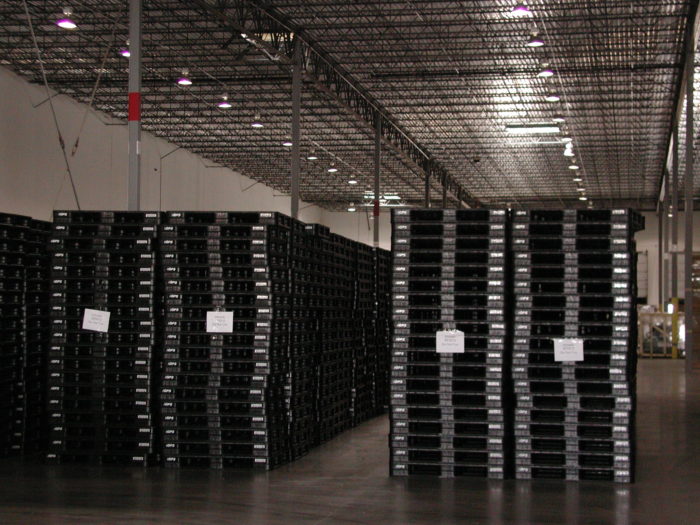Logistics is often the most expensive part of running a business. That broad term covers the processing, storage, and transportation of not only your products but also the components or ingredients used to make them. If any one of those elements isn’t perfectly coordinated with the others, your Total Cost of Business (TCOB) can needlessly go up. You may have had an experience with an eager purchasing agent looking to take advantage of a discount rate on components or ingredients by buying quantities of components that represent several quarters’ worth of production. When this happens, you may end up paying more to store these components than they are worth.
Supply chain improvement opportunities focus on correcting these kinds of goal misalignments. They help create flexibility in storage, production, and transportation to make sure you fulfill all seven R’s of efficient supply chain management. Improving your supply chain ensures you have the right product, at the right place, at the right price, for the right customer, at the right time, in the right condition, in the right quantity.
5 Supply Chain Improvement Opportunities
- Audit Your Supply Chain for Transparency
- Take Advantage of Automation
- Monitor Your Logistics in Real Time
- Analyze Vendor Performance
- Streamline Operations and Focus on Core Business
1. Audit Your Supply Chain for Transparency
Often, the supply chain errors that cost you the most money are the product of miscommunication and misunderstanding. None of the standard supply chain “R’s” deal with getting the right information to the right person, but we’d argue that’s a crucial first step. Due to the way supply chains expand and evolve over time, logistics are frequently coordinated over multiple sites with multiple supervisors. The deadlines and pressures of the supply chain can keep personnel and teams from communicating all but the bare minimum of information–not ideal in a situation in which communication is key. For this reason, any program of supply chain improvement should begin with a thorough audit of all locations in the supply chain to make certain they are sharing all necessary data.
At a minimum, this audit should include available sites in the supply chain for storage and production and their maximum cost-effective capacities. This will allow your supply chain to capitalize on reduced prices for components or other opportunities without overwhelming your logistics system.
2. Take Advantage of Automation
One of the most cost-effective supply chain improvement opportunities is industrial automation within the supply chain. Increasing capacity to capitalize on a surge in demand or a sudden fall in the prices of components has traditionally meant hiring significant numbers of laborers on short notice. In the modern supply chain, finding numbers of qualified laborers in short order can be a challenge–and a costly one, as workers need wages and may also be paid overtime.
Automated warehouse systems, on the other hand, are always available and ready. Throughput can be increased to make the most of supply chain automation, helping companies deal with rising demand without a significant increase in costs. When the spike in demand ends, the machines can be returned to a normal operating rate.
3. Monitor Your Logistics in Real Time
 Technology allows real-time communications globally, letting you observe product inventories and their transit from manufacturer to retailer. Creating a supply chain that can offer this sort of monitoring allows you and your employees to audit the performance of your supply chain and divert attention and resources where they are needed.
Technology allows real-time communications globally, letting you observe product inventories and their transit from manufacturer to retailer. Creating a supply chain that can offer this sort of monitoring allows you and your employees to audit the performance of your supply chain and divert attention and resources where they are needed.
Only real-time logistics management can allow for the redirection of canceled orders in a timely manner and can locate excess inventory in order to swiftly fill unexpected orders.
In the world of just-in-time delivery, this is a vital supply chain improvement. While planning ahead ensures that there is enough product on hand to meet previously placed orders, only real-time logistics management can allow for the redirection of canceled orders in a timely manner and can locate excess inventory in order to swiftly fill unexpected orders on short notice.
4. Analyze Vendor Performance
A company needs its vendors to perform at peak efficiency. A load of materials that arrives late, in insufficient quantities, or in a condition that isn’t fit for use costs the company money in unfulfilled orders and forces them to look for alternate sources in order to fulfill orders quickly. Monitoring vendor performance allows a company to partner with the best sources available for their materials and to anticipate any possible shortfalls.
5. Streamline Operations and Focus on Core Business
 As any operations manager knows, supply chain operations are very complex. Often, as supply chain procedures are developed, inefficient solutions that were meant as short-term fixes become long-term standard operating procedures. Effectively, these fixes are additional expenses in labor, time, and equipment that are extraneous to the business of selling your products. Removing unnecessary elements like these is a huge supply chain improvement opportunity that can improve operational efficiency, and, in doing so, lower the Total Cost of Business (TCOB).
As any operations manager knows, supply chain operations are very complex. Often, as supply chain procedures are developed, inefficient solutions that were meant as short-term fixes become long-term standard operating procedures. Effectively, these fixes are additional expenses in labor, time, and equipment that are extraneous to the business of selling your products. Removing unnecessary elements like these is a huge supply chain improvement opportunity that can improve operational efficiency, and, in doing so, lower the Total Cost of Business (TCOB).
A pallet pooling provider rents the shipping platforms needed to get products to market and manages their retrieval and reuse.
A good example of an additional, unnecessary expense is an internal pallet pool. While shipping platforms are absolutely necessary to move products through a mechanized supply chain, they cannot be sold to recoup handling and transport costs; they only enable transport to market and are either discarded afterward or retrieved at a substantial cost. Coordinating return trips for pallets and their disposal is a distraction from the primary logistics that make a profit, and thanks to third-party pallet pooling programs, it’s no longer necessary.
A pallet pooling provider rents the shipping platforms needed to get products to market and manages their retrieval and reuse. This frees companies from the need to procure, store, maintain, retrieve, and repair or dispose of their pallets. Streamlining a business in this way ultimately provides significant cost savings on facilities, labor, and transportation that reduce the total cost of doing business (TCOB).
The iGPS pallet pooling program provides plastic shipping platforms when and where they are needed through depots across the U.S. and Canada. To implement a supply chain improvement that streamlines your supply chain and saves you money, give our team a call at 1-800-884-0225, email a specialist at switch@igps.net, or visit our contact page.



